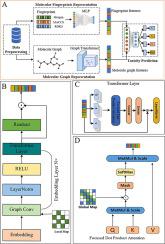当前位置:
X-MOL 学术
›
J. Adv. Res.
›
论文详情
Our official English website, www.x-mol.net, welcomes your feedback! (Note: you will need to create a separate account there.)
Multi-task aquatic toxicity prediction model based on multi-level features fusion
Journal of Advanced Research ( IF 11.4 ) Pub Date : 2024-06-04 , DOI: 10.1016/j.jare.2024.06.002 Xin Yang 1 , Jianqiang Sun 2 , Bingyu Jin 3 , Yuer Lu 4 , Jinyan Cheng 4 , Jiaju Jiang 5 , Qi Zhao 3 , Jianwei Shuai 6
Journal of Advanced Research ( IF 11.4 ) Pub Date : 2024-06-04 , DOI: 10.1016/j.jare.2024.06.002 Xin Yang 1 , Jianqiang Sun 2 , Bingyu Jin 3 , Yuer Lu 4 , Jinyan Cheng 4 , Jiaju Jiang 5 , Qi Zhao 3 , Jianwei Shuai 6
Affiliation

|
With the escalating menace of organic compounds in environmental pollution imperiling the survival of aquatic organisms, the investigation of organic compound toxicity across diverse aquatic species assumes paramount significance for environmental protection. Understanding how different species respond to these compounds helps assess the potential ecological impact of pollution on aquatic ecosystems as a whole. Compared with traditional experimental methods, deep learning methods have higher accuracy in predicting aquatic toxicity, faster data processing speed and better generalization ability. This article presents ATFPGT-multi, an advanced multi-task deep neural network prediction model for organic toxicity. The model integrates molecular fingerprints and molecule graphs to characterize molecules, enabling the simultaneous prediction of acute toxicity for the same organic compound across four distinct fish species. Furthermore, to validate the advantages of multi-task learning, we independently construct prediction models, named ATFPGT-single, for each fish species. We employ cross-validation in our experiments to assess the performance and generalization ability of ATFPGT-multi. The experimental results indicate, first, that ATFPGT-multi outperforms ATFPGT-single on four fish datasets with AUC improvements of 9.8%, 4%, 4.8%, and 8.2%, respectively, demonstrating the superiority of multi-task learning over single-task learning. Furthermore, in comparison with previous algorithms, ATFPGT-multi outperforms comparative methods, emphasizing that our approach exhibits higher accuracy and reliability in predicting aquatic toxicity. Moreover, ATFPGT-multi utilizes attention scores to identify molecular fragments associated with fish toxicity in organic molecules, as demonstrated by two organic molecule examples in the main text, demonstrating the interpretability of ATFPGT-multi. In summary, ATFPGT-multi provides important support and reference for the further development of aquatic toxicity assessment. All of codes and datasets are freely available online at .
中文翻译:

基于多层次特征融合的多任务水生毒性预测模型
随着环境污染中有机化合物的威胁不断升级,危及水生生物的生存,不同水生物种有机化合物毒性的研究对于环境保护具有重要意义。了解不同物种对这些化合物的反应有助于评估污染对整个水生生态系统的潜在生态影响。与传统实验方法相比,深度学习方法预测水生毒性的准确性更高、数据处理速度更快、泛化能力更好。本文介绍了 ATFPGT-multi,一种先进的有机毒性多任务深度神经网络预测模型。该模型集成了分子指纹和分子图来表征分子,从而能够同时预测四种不同鱼类中相同有机化合物的急性毒性。此外,为了验证多任务学习的优势,我们为每种鱼类独立构建了预测模型,名为 ATFPGT-single。我们在实验中采用交叉验证来评估 ATFPGT-multi 的性能和泛化能力。实验结果表明,首先,ATFPGT-multi 在四个鱼类数据集上优于 ATFPGT-single,AUC 分别提高了 9.8%、4%、4.8% 和 8.2%,证明了多任务学习相对于单任务学习的优越性学习。此外,与以前的算法相比,ATFPGT-multi 优于比较方法,强调我们的方法在预测水生毒性方面表现出更高的准确性和可靠性。 此外,ATFPGT-multi 利用注意力评分来识别有机分子中与鱼类毒性相关的分子片段,如正文中的两个有机分子示例所示,证明了 ATFPGT-multi 的可解释性。综上所述,ATFPGT-multi为水生毒性评估的进一步发展提供了重要的支持和参考。所有代码和数据集都可以在网上免费获得。
更新日期:2024-06-04
中文翻译:

基于多层次特征融合的多任务水生毒性预测模型
随着环境污染中有机化合物的威胁不断升级,危及水生生物的生存,不同水生物种有机化合物毒性的研究对于环境保护具有重要意义。了解不同物种对这些化合物的反应有助于评估污染对整个水生生态系统的潜在生态影响。与传统实验方法相比,深度学习方法预测水生毒性的准确性更高、数据处理速度更快、泛化能力更好。本文介绍了 ATFPGT-multi,一种先进的有机毒性多任务深度神经网络预测模型。该模型集成了分子指纹和分子图来表征分子,从而能够同时预测四种不同鱼类中相同有机化合物的急性毒性。此外,为了验证多任务学习的优势,我们为每种鱼类独立构建了预测模型,名为 ATFPGT-single。我们在实验中采用交叉验证来评估 ATFPGT-multi 的性能和泛化能力。实验结果表明,首先,ATFPGT-multi 在四个鱼类数据集上优于 ATFPGT-single,AUC 分别提高了 9.8%、4%、4.8% 和 8.2%,证明了多任务学习相对于单任务学习的优越性学习。此外,与以前的算法相比,ATFPGT-multi 优于比较方法,强调我们的方法在预测水生毒性方面表现出更高的准确性和可靠性。 此外,ATFPGT-multi 利用注意力评分来识别有机分子中与鱼类毒性相关的分子片段,如正文中的两个有机分子示例所示,证明了 ATFPGT-multi 的可解释性。综上所述,ATFPGT-multi为水生毒性评估的进一步发展提供了重要的支持和参考。所有代码和数据集都可以在网上免费获得。
















































 京公网安备 11010802027423号
京公网安备 11010802027423号